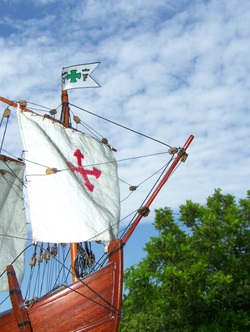 The boat-building project around our house continues for the 2014 Everglades Challenge race. Bowsprits -- they aren't just for schooners any more. With the hull and decks trimmed down to the quick, the Frankenscot is ready to take shape. Starting with some additional length up front. Modern racing boats have taken to using carbon fiber, and making the sprits retractable. To install one on Frankenscot, the first step is to cut a hole in the bow of the boat. Nothing says "seaworthy" quite so convincingly as that. The Frankenscot bowsprit (Frankensprit?) began life as a section from an old Classic Moth mast, which in turn came from one of those yellow Escape Rumba boats. The sprit extends five feet out from the front of the boat, allowing us (we hope!) to attach the foot of a large spinnaker-like sail (technically, a gennaker) to the end of the sprit. The gennaker should help the Frankenscot gain a few knots on a reach. Using swaths of fiberglass dripping with resin, Captain TwoBeers reinforced the entry and housing for the sprit from inside the boat. Fiberglass work is itchy and stinky under the best of conditions, never mind when triple-digit temperatures help the resin kick up a hot, toxic funk in the close quarters of the forepeak. "Forepeak" being a fancy name for the triangular wedge of space closed in by the deck at the front of the boat. When we have supercargo aboard the non-modified Flying Scot, we refer to this area as "the bear-cave." If you are the sort of small, youthful person who likes to bring Matchbox cars onboard, the bear-cave makes an excellent fort. It's roomy and private and protected from waves. If you are less youthful and small, the bear-cave still protects a person from waves, but the floorplan shrinks. If you suffer from claustrophobia, well, you'll want to take up another sport. Or anyway another boat design. Thanks to Paul (Brother Paul-E) Silvernail for the images in the slide show below.
2 Comments
Greg duncan
7/11/2013 12:28:26 pm
Looking good. dull the sharp edges.cause you are going to "Fly". I like that a Moth spar made the boat, I should send a Moth Sticker as a parts inventory marker. Email me your address.
Reply
Amy
7/14/2013 01:22:13 am
Thanks Greg -- Will do!
Reply
Leave a Reply. |
About the Blog
A lot of ground gets covered on this blog -- from sailboat racing to book suggestions to plain old piffle. FollowTrying to keep track? Follow me on Facebook or Twitter or if you use an aggregator, click the RSS option below.
Old school? Sign up for the newsletter and I'll shoot you a short e-mail when there's something new.
Archives
June 2024
Categories
All
|
 RSS Feed
RSS Feed
